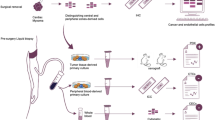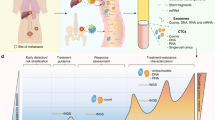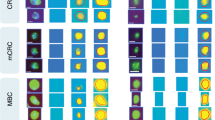Abstract
Prostate cancer has a wide spectrum of biological aggressiveness, and where an individual tumor lies within this spectrum can be difficult to characterize at diagnosis. The degree of tumor vascularization in prostate cancer correlates with disease progression and, thus, markers of angiogenesis are potential indicators of clinical outcome. Identification of improved prognostic markers would have a substantial effect on patient outcomes. Such markers would also be invaluable in assessments of the effectiveness of experimental chemotherapeutic regimens and antiangiogenic drugs that are currently under investigation. Bone-marrow-derived circulating endothelial progenitors (CEPs) and circulating endothelial cells (CECs) play an integral part in neovascularization and their levels in the circulation correlate with disease progression and therapeutic response in various settings. Although CECs and CEPs are yet to be thoroughly investigated in prostate cancer, the evidence suggests that these markers may be of use in the prostate-cancer setting. We review current understanding of the contributions of CEPs and CECs to tumor progression, and discuss their potential as prognostic markers.
Key Points
-
Pretreatment levels of circulating endothelial progenitors (CEPs) and viable circulating endothelial cells (CECs) might predict disease progression
-
CEP levels during treatment could be used to identify the optimum biological dose and best treatment regimens
-
Levels of apoptotic CECs indicate the efficacy of treatments that target the tumor vasculature
-
Levels of CECs and CEPs could potentially be considered in conjunction with PSA levels
This is a preview of subscription content, access via your institution
Access options
Subscribe to this journal
Receive 12 print issues and online access
$209.00 per year
only $17.42 per issue
Buy this article
- Purchase on Springer Link
- Instant access to full article PDF
Prices may be subject to local taxes which are calculated during checkout

Similar content being viewed by others
References
Hanahan D and Weinberg RA (2000) The hallmarks of cancer. Cell 100: 57–70
Risau W (1997) Mechanisms of angiogenesis. Nature 386: 671–674
Risau W and Flamme I (1995) Vasculogenesis. Annu Rev Cell Dev Biol 11: 73–91
Tepper OM et al. (2005) Adult vasculogenesis occurs through in situ recruitment, proliferation, and tubulization of circulating bone marrow-derived cells. Blood 105: 1068–1077
Asahara T et al. (1999) Bone marrow origin of endothelial progenitor cells responsible for postnatal vasculogenesis in physiological and pathological neovascularization. Circ Res 85: 221–228
Davidoff AM et al. (2001) Bone marrow-derived cells contribute to tumor neovasculature and, when modified to express an angiogenesis inhibitor, can restrict tumor growth in mice. Clin Cancer Res 7: 2870–2879
Garcia-Barros M et al. (2003) Tumor response to radiotherapy regulated by endothelial cell apoptosis. Science 300: 1155–1159
Folkman J (1990) What is the evidence that tumors are angiogenesis dependent. J Natl Cancer Inst 82: 4–6
Bergers G et al. (2000) Matrix metalloproteinase-9 triggers the angiogenic switch during carcinogenesis. Nat Cell Biol 2: 737–744
Hlatky L et al. (2002) Clinical application of antiangiogenic therapy: microvessel density, what it does and doesn't tell us. J Natl Cancer Inst 94: 883–893
Wakui S et al. (1992) Tumour angiogenesis in prostatic carcinoma with and without bone marrow metastasis: a morphometric study. J Pathol 168: 257–262
Weidner N et al. (1993) Tumor angiogenesis correlates with metastasis in invasive prostate carcinoma. Am J Pathol 143: 401–409
Borre M et al. (1998) Microvessel density predicts survival in prostate cancer patients subjected to watchful waiting. Br J Cancer 78: 940–944
Rogatsch H et al. (1997) Microvessel density in core biopsies of prostatic adenocarcinoma: a stage predictor? J Pathol 182: 205–210
Halvorsen OJ et al. (2000) Independent prognostic importance of microvessel density in clinically localized prostate cancer. Anticancer Res 20: 3791–3799
Silberman MA et al. (1997) Tumor angiogenesis correlates with progression after radical prostatectomy but not with pathologic stage in Gleason sum 5 to 7 adenocarcinoma of the prostate. Cancer 79: 772–779
Vergis R et al. (2008) Intrinsic markers of tumour hypoxia and angiogenesis in localised prostate cancer and outcome of radical treatment: a retrospective analysis of two randomised radiotherapy trials and one surgical cohort study. Lancet Oncol 9: 342–351
Lin Y et al. (2000) Origins of circulating endothelial cells and endothelial outgrowth from blood. J Clin Invest 105: 71–77
Quaini F et al. (2002) Chimerism of the transplanted heart. N Engl J Med 346: 5–15
Thiele J et al. (2004) Mixed chimerism of cardiomyocytes and vessels after allogeneic bone marrow and stem-cell transplantation in comparison with cardiac allografts. Transplantation 77: 1902–1905
Jiang S et al. (2004) Transplanted human bone marrow contributes to vascular endothelium. Proc Natl Acad Sci USA 101: 16891–16896
Hocht-Zeisberg E et al. (2004) Cellular repopulation of myocardial infarction in patients with sex-mismatched heart transplantation. Eur Heart J 25: 749–758
Murry CE et al. (2004) Haematopoietic stem cells do not transdifferentiate into cardiac myocytes in myocardial infarcts. Nature 428: 664–668
Ziegelhoeffer T et al. (2004) Bone marrow-derived cells do not incorporate into the adult growing vasculature. Circ Res 94: 230–238
Reyes M et al. (2002) Origin of endothelial progenitors in human postnatal bone marrow. J Clin Invest 109: 337–346
Dwenger A et al. (2004) Transplanted bone marrow cells preferentially home to the vessels of in situ generated murine tumors rather than of normal organs. Stem Cells 22: 86–92
Li H et al. (2004) Utilization of bone marrow-derived endothelial cell precursors in spontaneous prostate tumors varies with tumor grade. Cancer Res 64: 6137–6143
De Palma M et al. (2003) Targeting exogenous genes to tumor angiogenesis by transplantation of genetically modified hematopoietic stem cells. Nat Med 9: 789–795
Gothert JR et al. (2004) Genetically tagging endothelial cells in vivo: bone marrow-derived cells do not contribute to tumor endothelium. Blood 104: 1769–1777
Lyden D et al. (2001) Impaired recruitment of bone-marrow-derived endothelial and hematopoietic precursor cells blocks tumor angiogenesis and growth. Nat Med 7: 1194–1201
Peters BA et al. (2005) Contribution of bone marrow-derived endothelial cells to human tumor vasculature. Nat Med 11: 261–262
Sangai T et al. (2005) Effect of differences in cancer cells and tumor growth sites on recruiting bone marrow-derived endothelial cells and myofibroblasts in cancer-induced stroma. Int J Cancer 115: 885–892
Tuxhorn JA et al. (2001) Reactive stroma in prostate cancer progression. J Urol 166: 2472–2483
Stoll BR et al. (2003) A mathematical model of the contribution of endothelial progenitor cells to angiogenesis in tumors: implications for antiangiogenic therapy. Blood 102: 2555–2561
Ferrara N and Davis-Smyth T (1997) The biology of vascular endothelial growth factor. Endocr Rev 18: 4–25
Duda DG et al. (2006) Evidence for incorporation of bone marrow-derived endothelial cells into perfused blood vessels in tumors. Blood 107: 2774–2776
Shaked Y et al. (2006) Therapy-induced acute recruitment of circulating endothelial progenitor cells to tumors. Science 313: 1785–1787
Loomans CJM et al. (2006) Angiogenic murine endothelial progenitor cells are derived from a myeloid bone marrow fraction and can be identified by endothelial NO synthase expression. Arterioscler Thromb Vasc Biol 26: 1760–1767
Pelosi E et al. (2002) Identification of the hemangioblast in postnatal life. Blood 100: 3203–3208
Schofield R (1983) The stem cell system. Biomed Pharmacother 37: 375–380
Bertolini F et al. (2003) Maximum tolerable dose and low-dose metronomic chemotherapy have opposite effects on the mobilization and viability of circulating endothelial progenitor cells. Cancer Res 63: 4342–4346
Shaked Y et al. (2005) Genetic heterogeneity of the vasculogenic phenotype parallels angiogenesis; implications for cellular surrogate marker analysis of antiangiogenesis. Cancer Cell 7: 101–111
Mancuso P et al. (2001) Resting and activated endothelial cells are increased in the peripheral blood of cancer patients. Blood 97: 3658–3661
Beerepoot LV et al. (2004) Increased levels of viable circulating endothelial cells are an indicator of progressive disease in cancer patients. Ann Oncol 15: 139–145
Zhang H et al. (2005) Circulating endothelial progenitor cells in multiple myeloma: implications and significance. Blood 105: 3286–3294
Lin EH et al. (2007) Elevated circulating endothelial progenitor marker CD133 messenger RNA levels predict colon cancer recurrence. Cancer 110: 534–542
Tanaka F et al. (2001) Evaluation of angiogenesis in non-small cell lung cancer: comparison between anti-CD34 antibody and anti-CD105 antibody. Clin Cancer Res 7: 3410–3415
Tomisaki S et al. (1996) Microvessel quantification and its possible relation with liver metastasis in colorectal cancer. Cancer 77: 1722–1728
Ridell B and Norrby K (2001) Intratumoral microvascular density in malignant lymphomas of B-cell origin. APMIS 109: 66–72
Mancuso P et al. (2006) Circulating endothelial-cell kinetics and viability predict survival in breast cancer patients receiving metronomic chemotherapy. Blood 108: 452–459
Graham CH et al. (1994) Extent of vascularization as a prognostic indicator in thin (<0.76 mm) malignant melanomas. Am J Pathol 145: 510–514
Meitar D et al. (1996) Tumor angiogenesis correlates with metastatic disease, N-myc amplification, and poor outcome in human neuroblastoma. J Clin Oncol 14: 405–414
Mentzel T et al. (2001) The association between tumour progression and vascularity in myxofibrosarcoma and myxoid/round cell liposarcoma. Virchows Arch 438: 13–22
Joo HJ et al. (2004) Increased expression of caveolin-1 and microvessel density correlates with metastasis and poor prognosis in clear cell renal cell carcinoma. BJU Int 93: 291–296
Weidner N et al. (1992) Tumor angiogenesis: a new significant and independent prognostic indicator in early-stage breast carcinoma. J Natl Cancer Inst 84: 1875–1887
Goodheart MJ et al. (2002) Ovarian cancer p53 mutation is associated with tumor microvessel density. Gynecol Oncol 86: 85–90
Sezer O et al. (2000) Bone marrow microvessel density is a prognostic factor for survival in patients with multiple myeloma. Ann Hematol 79: 574–577
Mundy GR (2002) Metastasis to bone: causes, consequences and therapeutic opportunities. Nat Rev Cancer 2: 584–593
Shaked Y et al. (2005) Optimal biologic dose of metronomic chemotherapy regimens is associated with maximum antiangiogenic activity. Blood 106: 3058–3061
National Cancer Institute: clinical trials in prostate cancer [http://www.cancer.gov/search/ResultsClinicalTrialsAdvanced.aspx? protocolsearchid=3727367] (accessed 24 June 2008)
Beaudry P et al. (2005) Differential effects of vascular endothelial growth factor receptor-2 inhibitor ZD6474 on circulating endothelial progenitors and mature circulating endothelial cells: implications for use as a surrogate marker of antiangiogenic activity. Clin Cancer Res 11: 3514–3522
Willett CG et al. (2005) Surrogate markers for antiangiogenic therapy and dose-limiting toxicities for bevacizumab with radiation and chemotherapy: continued experience of a phase I trial in rectal cancer patients. J Clin Oncol 23: 8136–8139
Norden-Zfoni A et al. (2007) Blood-based biomarkers of SU11248 activity and clinical outcome in patients with metastatic imatinib-resistant gastrointestinal stromal tumor. Clin Cancer Res 13: 2643–2650
Acknowledgements
The authors were supported by funds from the Melbourne Urology Trust, including a generous gift from Roger Riordan of the Cybec Trust. B Namdarian is supported by a Raelene Boyle Scholarship from the Royal Australasian College of Surgeons. NM Corcoran was supported by a Benjamin Rank Surgical Fellowship from the Royal Melbourne Hospital, and a National Health and Medical Research Council Medical Postgraduate Scholarship.
Author information
Authors and Affiliations
Corresponding author
Ethics declarations
Competing interests
The authors declare no competing financial interests.
Rights and permissions
About this article
Cite this article
Georgiou, H., Namdarian, B., Corcoran, N. et al. Circulating endothelial cells as biomarkers of prostate cancer. Nat Rev Urol 5, 445–454 (2008). https://doi.org/10.1038/ncpuro1188
Received:
Accepted:
Issue Date:
DOI: https://doi.org/10.1038/ncpuro1188
This article is cited by
-
Phase II study of Cilengitide (EMD 121974, NSC 707544) in patients with non-metastatic castration resistant prostate cancer, NCI-6735. A study by the DOD/PCF prostate cancer clinical trials consortium
Investigational New Drugs (2012)
-
Inflammation Associated With Obesity: Relationship With Blood and Bone Marrow Endothelial Cells
Obesity (2011)
-
The PCa Tumor Microenvironment
Cancer Microenvironment (2011)
-
Open-label, phase I dose-escalation study of sodium selenate, a novel activator of PP2A, in patients with castration-resistant prostate cancer
British Journal of Cancer (2010)



